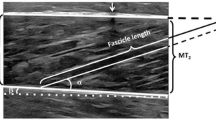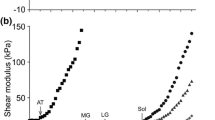Abstract
Changes in connective tissues of the skeletal muscle-tendon unit (MTU) of aging animal muscles have been associated with increased passive viscoelastic properties. This study examined whether similar changes in the viscoelastic properties were present in short calf MTUs of older women in vivo. Fifteen women 68–87 years of age with short calf MTUs, as represented by limited active dorsiflexion (DF) range of motion (ROM) of ≤5°, and 15 women 20–26 years of age without decreased DF ROM participated. A Kin-Com dynamometer stretched the MTU from plantarflexion to maximal DF at the slow velocity of 5° s−1 (0.087 rad s−1) and the fast velocity of 120° s−1 (2.094 rad s−1) with minimal surface electromyogram activity in the soleus, gastrocnemius, and tibialis anterior muscles. Two-way analysis of variance (ANOVA) tests for repeated measures (Velocity × Group) indicated that all women showed greater passive torque, average passive elastic stiffness, and total absorbed passive elastic energy for the fast stretch than for the slow stretch (P<0.001). The older women had greater percent increases for the average passive torque (30%) and total absorbed passive elastic energy (26%) for the fast stretch than the younger women (P<0.05), who had 17.5 and 13% increases, respectively. The older women had less maximal and average passive torque (Nm) and total absorbed passive elastic energy (°Nm), but greater average passive elastic stiffness (Nm°−1) at both stretch velocities (P<0.001). The results indicated that short calf MTUs of older women have increased passive viscoelastic properties that could have implications for balance and ambulatory function.




Similar content being viewed by others
References
Alnaqeeb MA, Goldspink G (1987) Changes in fiber type, number and diameter in developing and ageing skeletal muscle. J Anat 153:31–45
Alnaqeeb MA, Al Zaid NS, Goldspink G (1984) Connective tissue changes and physical properties of developing and ageing skeletal muscle. J Anat 139:677–689
Bach T, Chapman A, Calvert T (1983) Mechanical resonance of the human body during voluntary oscillations about the ankle joint. J Biomech 16(1):85–90
Banus MG, Zetlin AM (1938) The relation of isometric tension to length in skeletal muscle. J Cell Comp Physiol 12:403–420
Blanpied P, Smidt GL (1992) Human plantarflexor stiffness to multiple single-stretch trials. J Biomech 25:29–39
Borg TK, Caufield JB (1980) Morphology of connective tissue in skeletal muscle. Tissue Cell 12:197–207
Brodie TG (1895) The extensibility of muscle. J Anat Physiol 29:367–388
Brown WF, Strong MJ, Snow R (1988) Methods for estimating numbers of motor units in biceps-brachialis muscles and losses of motor units with aging. Muscle Nerve 11:423–432
Campbell MJ, McComas AJ, Petito F (1973) Physiological changes in ageing muscles. J Neurol Neurosurg Psych 36:174–182
Doherty TJ, Vandervoort AA, Taylor AW, Brown WF (1993) Effects of motor unit losses on strength in older men and women. J Appl Physiol 74:868–874
Fukunaga T, Kubo K, Kawakami Y, Fukashiro S, Kanehisa H, Maganaris CN (2001) In vivo behavior of human muscle tendon during walking. Proc R Soc Lond 268:229–233
Funatsu T, Higuchi H, Ishiwata S (1996) Elastic filaments in skeletal muscle revealed by selective removal of thin filaments with plasma gelsolin. J Cell Biol 110:53–62
Gajdosik RL (1997) Influence of age on calf muscle length and passive stiffness variables at different stretch velocities. Isokinetics Exercise Sci 6:163–174
Gajdosik RL (2001) Passive extensibility of skeletal muscle: review of the literature with clinical implications. Clin Biomech 16:87–101
Gajdosik RL, Vander Linden DW, Williams AK (1996) Influence of age on concentric isokinetic torque and passive extensibility variables of the calf muscles of women. Eur J Appl Physiol 74:279–286
Gajdosik RL, Vander Linden DW, Williams AK (1999) Influence of age on length and passive elastic stiffness characteristics of the calf muscle-tendon unit of women. Phys Ther 79:827–838
Gajdosik RL, Vander Linden DW, McNair PJ, Riggin RJ, Albertson JS, Mattick DJ, Wegley JC (2004) Slow passive stretch and release characteristics of the calf muscles of older women with limited dorsiflexion range of motion. Clin Biomech 19(4):398–406
Haycraft JB (1904) The elasticity of animal tissues. J Physiol 31:392–409
Herbert RD, Moseley AM, Butler JE, Gandevia SC (2002) Changes in length of relaxed muscle fascicles and tendons with knee and ankle movements in humans. J Physiol Mar 1 539(Pt 2):637–645
Hermens HJ, Freriks B, Disselhorst-Klug C, Rau G (2000) Development of recommendations for SEMG sensors and sensor placement procedures. J Electromyogr Kinesiol 10:361–374
Huijing PA, Ettema GJC (1988) Length-force characteristics of aponeurosis in passive muscle and during isometric and slow dynamic contractions of rat gastrocnemius muscle. Acta Morphol Neerl-Scand 26:51–62
James B, Parker AW (1989) Active and passive mobility of lower limb joints in elderly men and women. Am J Phys Med Rehabil 68(4):162–167
Kanda K, Hashizume K (1989) Changes in properties of medial gastrocnemius motor units in aging rats. J Neurophysiol 61:737–746
Kawakami Y, Muraoka S, Kanehisa H, Fukunaga T (2002) In vivo muscle fiber behaviour during counter-movement exercise in humans reveals a significant role for tendon elasticity. J Physiol 540(2):635–646
Kovanen V (1989) Effects of ageing and physical training on rat skeletal muscle. An experimental study on the properties of collagen, laminin, and fiber types in muscles serving different functions. Acta Physiol Scand Suppl 577:1–56
Kovanen V, Suominen H (1988) Effects of age and life-long endurance training on the passive mechanical properties of rat skeletal muscle. Compr Gerontol A 2:18–23
Kovanen V, Suominen H, Heikkinen E (1984) Mechanical properties of fast and slow skeletal muscle with special reference to collagen and endurance training. J Biomechanics 17:725–735
Kurokawa S, Fukunaga T, Nagano A, Fukashiro S (2003) Interaction between fascicles and tendinous structures during counter movement jumping investigated in vivo. J Appl Physiol 95:2306–2314
Lamontagne A, Malouin F, Richards CL (1997) Viscoelastic behavior of plantar flexor muscle-tendon unit at rest. J Orthop Sports Phys Ther 26(5):244–252
Le Veau BF (1992) In: Williams and Lissner’s biomechanics of human motion, 3rd edn. W. B. Saunders, Philadelphia, pp 33–37
Lexell J (1995) Human aging, muscle mass, and fiber type composition. J Gerontol 50(A):11–16
Lexell J, Henriksson-Larsen K, Winblad B, Sjostrom M (1983) Distribution of different fiber types in human skeletal muscles: effects of aging studied in whole muscle cross sections. Muscle Nerve 6:588–595
Lexell J, Taylor CC, Sjostrom M (1988) What is the cause of the ageing atrophy? Total number, size and proportion of different fiber types studied in whole vastus lateralis muscle from 15 to 83-year-old men. J Neurol Sci 84:275–294
Linke WA, Ivemeyer M, Olivieri N, Lolmerer B, Ruegg JC, Labeit S (1996) Towards a molecular understanding of the elasticity of titin. J Mol Biol 261:62–71
McNair PJ, Hewson DJ, Dombroski E, Stanley SN (2002) Stiffness and passive peak force changes at the ankle joint: the effect of different joint angular velocities 17:536–540
Purslow PP (1989) Strain-induced reorientation of an intramuscular connective tissue network:implications for passive muscle elasticity. J Biomech 22(1):21–31
Purslow PP, Trotter JA (1994) The morphology and mechanical properties of endomysium in series-fiberd muscles: variations with muscle length. J Muscle Res Cell Motil 15:299–308
Rice CL, Cunningham DA, Paterson DH, Lefcoe MS (1989) Arm and leg composition determined by computed tomography in young and elderly men. Clin Physiol 9:207–220
Rowe RWD (1974) Collagen fiber arrangement in intramuscular connective tissue: changes associated with muscle shortening and their possible relevance to raw meat toughness measurements. J Food Technol 9:501–508
Simons DG, Mense S (1998) Understanding and measurement of muscle tone as related to clinical muscle pain. Pain 75:1–17
Singer BJ, Dunne JW, Singer KP, Allison GT (2003) Velocity dependent passive plantarflexor resistive torque in patients with acquired brain injury. Clin Biomech 18:157–165
Sipila S, Suominen H (1995) Effects of strength and endurance training on thigh and leg muscle mass and composition in elderly women. J Appl Physiol 78:334–340
Tabary JC, Tabary C, Tardieu C, Tardieu G, Goldspink G (1972) Physiological and structural changes in the cat’s soleus muscle due to immobilization at different lengths by plaster casts. J Physiol 224:231–244
Tabary JC, Tardieu C, Tardieu G, Tabary C, Gagnard L (1976) Functional adaptation of sarcomere number of normal cat muscle. J Physiol 72:277–291
Taylor DC, Dayton JD, Seaber AV, Garrett WE (1990) Viscoelastic properties of muscle-tendon units. The biomechanical effects of stretching. Am J Sports Med 18(3):300–308
Trombitas K, Greaser M, Labeit S, Jin J-P, Kellermayer M, Helmes M, Granzier H (1998) Titin extensibility in situ: entropic elasticity of permanently folded and permanently unfolded molecular segments. J Cell Biol 140:853–859
Trotter JA, Purslow PP (1992) Functional morphology of the endomysium in series fibered muscles. J Morphol 212:109–122
Vandervoort AA, Chesworth BM, Cunningham DA, Paterson DH, Rechnitzer PA, Koval JJ (1992) Age and sex effects on mobility of the human ankle. J Gerontol 47:M17–M21
Wang K, Ramirez-Mitchell R (1983) A network of transverse and longitudinal intermediate filaments is associated with sarcomeres of adult vertebrate muscle. J Cell Biol 96:562–570
Wang K, McCarter R, Wright J, Beverly J, Ramirez-Mitchell R (1993) Viscoelasticity of the sarcomere matrix of skeletal muscles: the titin-myosin composite filament is a dual-stage molecular spring. Biophys J 64:1161–1177
Williams PE, Goldspink G (1978) Changes in sarcomere length and physiological properties in immobilized muscle. J Anat (Lond) 127:459–468
Williams PE, Goldspink G (1984) Connective tissue changes in immobilized muscle. J Anat (Lond) 138:342–350
Wilson G, Wood G, Elliott B (1991) Optimal stiffness of the series elastic component in a stretch-shorten cycle activity. J Appl Physiol 70(2):825–833
Zuurbier CJ, Everard AJ, van der Wees P, Juijing PA (1994) Length-force characteristics of the aponeurosis in the passive and active muscle condition and in the isolated condition. J Biomech 27:445–453
Acknowledgements
This study was funded by The National Institutes of Health (NIH) Grant No. R24 HD39629-04 through RehabNet~West, The University of Washington, Seattle, WA, and grants from The MJ Murdock Charitable Trust Foundation and The University of Montana (USA). The experiments in this study complied with the current laws of the United States of America.
Author information
Authors and Affiliations
Corresponding author
Rights and permissions
About this article
Cite this article
Gajdosik, R.L., Vander Linden, D.W., McNair, P.J. et al. Viscoelastic properties of short calf muscle-tendon units of older women: effects of slow and fast passive dorsiflexion stretches in vivo. Eur J Appl Physiol 95, 131–139 (2005). https://doi.org/10.1007/s00421-005-1394-4
Accepted:
Published:
Issue Date:
DOI: https://doi.org/10.1007/s00421-005-1394-4




